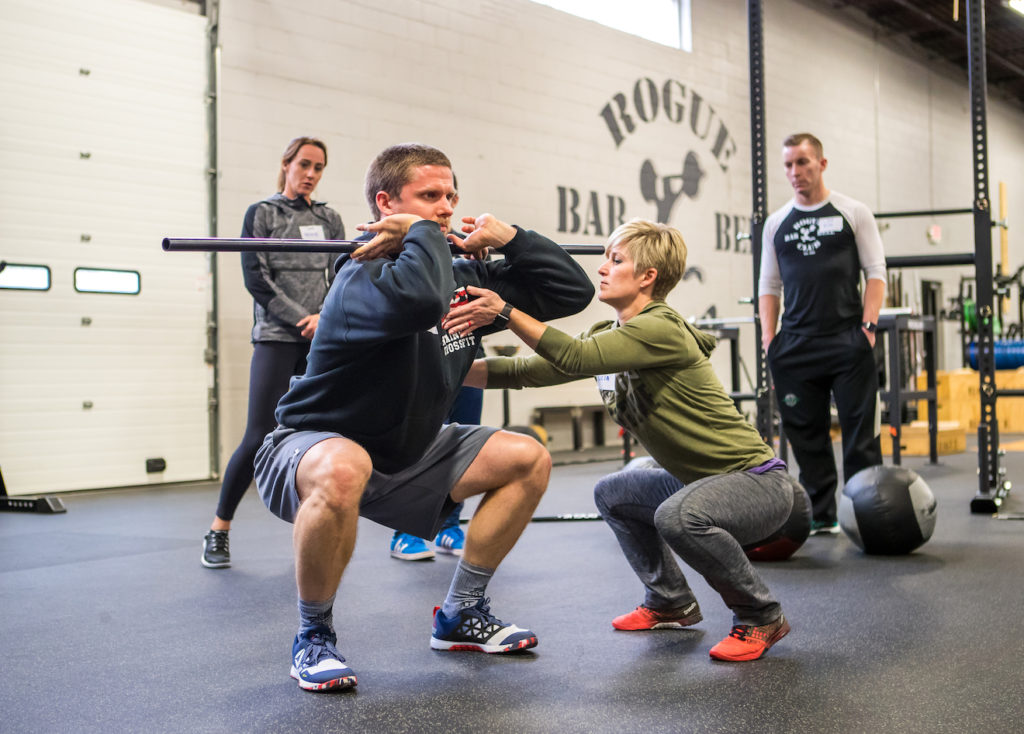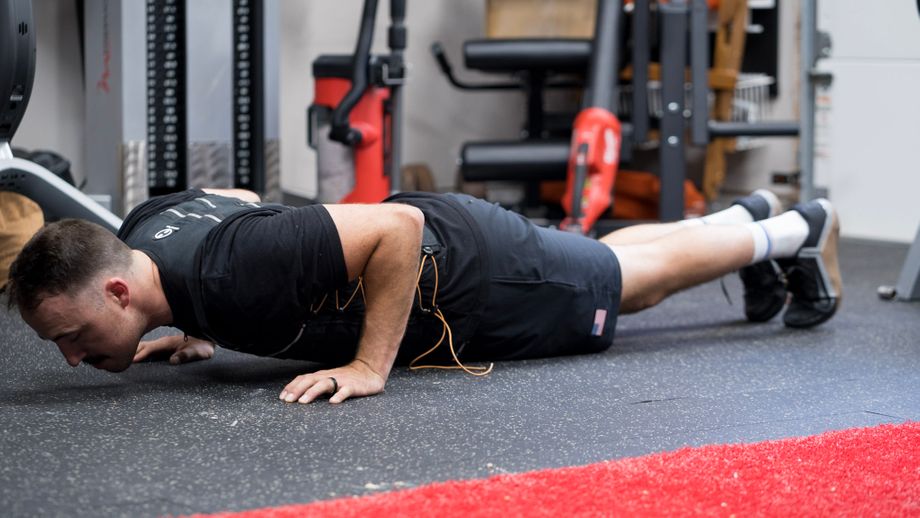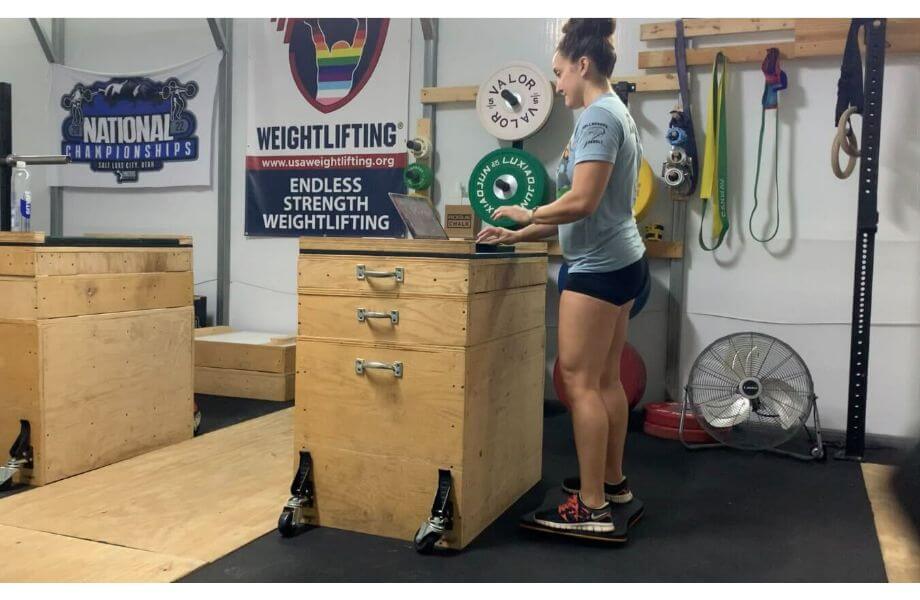Whether you’re looking to supplement your affiliate programming with weakness templates or want to replace your current CrossFit programming with new programming altogether, this guide has you covered.
A complete breakdown of the most popular functional fitness programs available on the market, below you’ll learn the pros and cons of the 10 best training programs for CrossFit.
CrossFittin’ Since 2016
Allow me to introduce myself: A former collegiate rugby player and marathoner, I’ve been a CrossFit athlete since 2016 and CrossFit L-1 certified trainer since 2018 who has had the pleasure of coaching throughout New York City and Connecticut.
I’ve also been a full-time fitness journalist for the last six years, writing for publications like Women’s Health, Healthline, Greatist, Shape Magazine, Men’s Health, Self, and more. My career as both a coach and journalist have given me the unique opportunity of seeing and testing nearly every training program for CrossFit on the market today.
Rest assured, however, this guide is not the child of my brain alone. All of the below notes have been corroborated by a team of other CrossFit athletes and program reviewers who have also tried their hands, hamstrings, and hineys at these programs in recent months.
The Best Training Plans for CrossFit
- Best Training Plan for CrossFit Overall: PRVN60
- Best Training Plan for CrossFit Competitors: HWPO PRO
- Best Personalized Training Plan for CrossFit: Misfit Athletics
- Best Training Plan for CrossFit Endurance: Aerobic Capacity by Chris Hinshaw
- Best Training Plan for CrossFit Gymnastics: Invictus Gymnastics
- Best CrossFit Training Program for Strength: Train Hard
- Best Training Plan for Hypertrophy: Functional Bodybuilding
- Best Training Plan for Mobility: Pliability
- Best Training Plan for Busy People (Quick Workouts): Street Parking
- Best Training Plan for CrossFit Beginners: CrossFit Mainsite
Best Training Plan for CrossFit Overall: PRVN60
Good for: CrossFit athletes who need to be told the intent of their workouts before tackling them
PRVN60 provides an efficient, effective way to develop your strength in conditioning with six weekly workouts that last 60 minutes.
Best Training Plan for CrossFit Competitors: HWPO PRO
Good for: People who are serious about making it to Semifinals and the CrossFit Games
The brainchild of CrossFit legend Matt Fraser, HWPO Pro is a progression-based program designed to develop athletes and prepare them for competition.
Most Personalized CrossFit Training Program: Misfit Athletics Hatchet Program
Good for: People who want to feel like they are getting individualized programming but without the price tag
Misfit Athletics offers several training options, with the Hatchet program helping athletes who are planning to compete at the Open and/or Quarterfinals level as an individual or team athlete. The program includes strength, metcons, intervals, monostructural work, and more.
Best Training Plan for CrossFit Endurance: Aerobic Capacity by Chris Hinshaw
Good for: Those who need to learn to pace and sustain a pace on runs, swims, and rows
Founded by legendary endurance coach Chris Hinshaw and utilized by CrossFit coaches, trainers, and athletes of all levels, Aerobic Capacity delivers personalized training for rowing, running, swimming, and other forms of exercise to help increase your aerobic capabilities.
Best Training Plan for CrossFit Gymnastics: Invictus Gymnastics
Good for: Anyone who wants to string together muscle-ups, add another 10 HSPU to their unbroken strict count, or get their first toes-to-bar
The Invictus Gymnastics program covers all common gymnastics skills in CrossFit with 10 training blocks per week divided among five days. The sessions are short and efficient, lasting between 10 to 20 minutes.
Best Training Plan for Classic CrossFit Workouts: Train Hard
Good for: Trainees who want an app-based online program structured like a classic CrossFit class.
Train Hard is a virtual training program designed by former CrossFit champion Jason Khalipa designed to help people get through training slumps and accomplish their fitness goals.
Best Training Plan for Hypertrophy: Functional Bodybuilding
Good for: People who love the structure and variety of CrossFit, but need something a bit lower in intensity
The Functional Bodybuilding Persist Program designed by Marcus Filly, former CrossFit Games athlete, offers exceptional programming for folks looking to improve mobility and increase muscle mass at the same time. Mobility and recovery is built-in to the warm-ups, cool-downs, and addressed on non-lifting days. It’s also appropriate for folks with limited equipment.
Best Training Plan for Mobility: Pliability
Good for: Any athlete who is currently limited by their mobility in any way
Pliability helps athletes with mobility and recovery, as well as mindfulness. The programming is highly customizable based on your needs, as each body moves differently.
Best Training Plan for Busy People (Quick Workouts): Street Parking
Good for: Athletes who want access to a wide variety of tracks (based on what equipment they have access to), as well as a robust Facebook community
Street Parking is a CrossFit-centric online programming option for people who want to achieve general physical fitness.
Best Training Plan for CrossFit Beginners: CrossFit Mainsite
Good for: People who know the basic CrossFit movements and are looking for a program that will maintain their fitness for free online
Pros:
- Makes workouts incredibly easy to scale
- Scaled, intermediate, and beginner options all outlined
- Community comes together in the comments
- Free!
Cons:
- Requires some equipment
- Strength-specific programming is rare
- Random rest days
Other Training Plans for CrossFit We Love
These days, nearly every athlete who’s ever been to the CrossFit Games has a training program available for purchase.
To be clear: We think this is a good thing! We love that the athletes are finding ways to monetize their knowledge base, and are excited for the athletes who get to take advantage of them.
However, we simply don’t have the bandwidth to provide complete break-downs on the programs that didn’t win gold in one category or another. Still, there are a few other programs we’d be remiss not to mention in some way, shape, or form.
The lovechild of the GOAT, Rich Froning, Mayhem Nation is a training mecca with an Everyday Athlete track and a Competitor track. For people who want to be like CrossFit games athletes Haley Adams, Baylee Rayl, Paige Powers, Tyler Christophel, Guilherme Malheiros, and Luke Parker, the Mayhem Competitor track is an incredible option.
Not for people who fear pain, this volume-heavy program includes multiple strength sessions per day, as well as accessory work, machine work, and metcons.
Designed by Ben Bergeron and the expert coaches associated with CrossFit New England, CompTrain was one of the first CrossFit training programs of its time. CompTrain currently has two programs available, “Games” and “Open”, which are both available through the CompTrain App.
The Open version features 1.5 to 2 hours of training programmed per day, designed to help athletes place as high on the Open leaderboard as they want to.
Pro tip: Even if you choose to invest and follow another training program, check out the CompTrain Podcast: Chasing Excellence. A series of conversations between CompTrain Founder Ben Bergeron and long-time CrossFit competitor Patrick Cummings, Chasing Excellence is a great listen for athletes who want to optimize their lives in and out of the gym.
The most popular and arguably most-successful Europe-based option, Progrm operates under the “work smarter, not harder” philosophy. Their programming, which has gotten many athletes to the Games and the Semifinals, isn’t for volume monsters or people who need sexy workout structures to convince them to move, and move fast. Simple but effective, The Progrm will help you become the best athlete you can be, one well-written workout at a time.
Created by mobility king Kelly Starrett, The Ready State is a mobility program designed for any athlete looking to improve their snatch, squat, or swing through mobility work. Previously known as MobilityWOD, The Ready State utilizes tools like lacrosse balls, foam rollers, and bands, which most other mobility programs do not.
Pliability, formerly ROMWOD, may have had a monopoly over the mobility CrossFit space, but I’ve had the pleasure of testing an emerging mobility platform, Movement Vault, which is also available in both online and app-based formats. Movement Vault may not have the celeb-sightings you get on Pliability, but the founder Grayson Wickham does an amazing job of making mobility accessible to the masses.

How We Picked the Best Training Plans for CrossFit
Every single program mentioned in our top picks list has been tested or, at the very least, thoroughly researched by one or more of the CrossFit experts on our team of reviewers. For programs we haven’t tried ourselves, we had certified personal trainers on our staff analyze the programming to look for things like structure, progressive overload, movement variety, and more.
By turning our bodies into test subjects, we are able to discern how effective each program is, as well as what kind of athlete (mentally and physically) is most likely to excel on a particular program.
As we tested the programs—and the workouts therein—we also asked ourselves questions such as:
- What movement patterns and modalities does this program prioritize?
- What goals is this program best-equipped to help you achieve?
- How long does it take to do each day’s program, start-to-finish?
- What kind of equipment does someone need to do this program?
- What kind of scaling options are included, if any?
Benefits of Following a Training Plan for CrossFit
CrossFit may incessantly preach “constantly varied functional movements” but there’s a difference between constantly varied and chaotic.
Will you see health and fitness benefits if you do a different workout you found on Instagram every day? Honestly, yes. For a period of time, you will see improvements in your overall fitness!
However, cherry-picking workouts from your social feeds has its downside.
For starters, you’ll probably bias a certain type of workout. For example, if you prefer to do long slow-and-go workouts, you’ll probably screenshot and then do the machine workouts you stumble on. Likewise, if you have a gymnastics background, you’re probably more likely to pick workouts with chest-to-bar, pull-ups, and handstand push-ups than workouts with heavy barbells.
It’s not necessarily bad to do workouts with movements that you enjoy. However, it will keep you from working on your weaknesses, and therefore actually progressing in the sport of CrossFit, which requires that you be proficient in a wide variety of movements and time domains.
In extreme situations, it could even cause you to ignore entire muscle groups, thus creating muscle imbalances, which increase your susceptibility to injury.
And, even if you make sure to do a variety of movement patterns and time domains, you’ll make less progress than you would if you did a program because random workouts do not intentionally progress workout-to-workout. An ideal program should follow principles of strength training and fitness, such as progressive overload and periodization1.

Buying and following one specific training program for CrossFit allows you to test all the movements patterns, time domains, and intensities that CrossFit utilizes. And more importantly: With built-in strength and skill progressions, you’ll subject yourself to more changes in weight, reps, rest, and intervals than you will with cherry-picking.
In other words, the benefit of following a training program for CrossFit is that it gets you better as effectively and efficiently as possible.
How to Choose the Best CrossFit Training Program for You
If you’re not quite sure which training program is right for you, answer these questions.
What Are My Goals?
Why do you want to invest in one of these programs? What are you trying to accomplish with the help of the program?
The answer to this question about goals is the number-one thing that will guide your next purchase.
If you don’t have the answer at the top of mind already, here are some questions you might ask yourself to figure it out:
- How many places do I want to advance in the CrossFit Open or Quarterfinals next year?
- What new skills am I committed to learning?
- What are the weak points in my game?
- Where do I want to be in a year?
What Is My Current Fitness Level?
You may dream of going to the CrossFit Games, but that doesn’t necessarily mean that a competitor’s track is a good option for you.
Competitor programs take it as a given that you can do all the higher level CrossFit skills (pistols, ring muscle-ups, chest-to-bar, for example) in a workout and that you can lift heavy-ass weights under fatigue (cleans for reps at 225/155, for example).
Some questions to ask yourself to figure out your current fitness level include:
- What percentage of the workouts at my current box (or programming) do I Rx?
- If I were to sign up for a local competition today, what division would I sign up for?
- What Wodapalooza division is most appropriate for my current fitness level?
- How long have I been doing CrossFit?
- What movements can I not do?
What’s My Budget?
When you set your budget, keep in mind that to actually do the workouts programmed you’ll probably need a full CrossFit gym.
Translation: You’ll either need to deck out your home garage, office, or spare room, or shell out the money for a monthly box membership, too.

How Much Time Do I Have Per Day?
Some of the above programs require 20 minutes a day, three days per week. Some require just one session every seven days. And some demand four to six hours a day, six days per week.
Not to be Captain Obvious, but it would be crazy to buy a program that requires 10 times the amount of time you can realistically allocate for fitness.
So, before you invest, take serious inventory of your Google calendar (read: family, work, and social obligations).
FAQs About CrossFit Training Programs
Got some general questions about CrossFit programming? Ahead, answers to some commonly asked questions about training programs for CrossFit.
How many days per week should you train CrossFit?
Ultimately, it depends who you ask. Plus, consider how much time you can commit to recovery each day, outside of training.
Typically, CrossFit recommends either a three-days-on, one-day-off model or a five-days-on, two-days-off model.
Broadly, that means most people workout five days per week.
And actually most CrossFit programs run on a similar clock. PRVN, for example, schedules a rest or recovery day on Thursday and Sunday. Meanwhile, HWPO schedules them on Thursday and Monday.
However, there is no universal workout schedule. You may need to work out less frequently if you are:
Also training another modality
Not recovering adequately between workouts
Sick
Navigating higher than normal (for you) stress levels
What is a CrossFit training program?
At its most basic, it’s a program that trains some or all of the modalities of the sport of functional fitness, at one or many of the intensity levels the sport trains them.
That means that there isn’t much similarity between programs.
Some programs, for example, prioritize higher-level gymnastics movements that make an appearance in the sport, while other training programs exclusively prioritize the Olympic Lifts, and still others prioritize cardio or general strength training.
All good training plans for CrossFit, though, will help you develop better “general physical preparedness,” which is the term used in CrossFit that essentially means “be pretty good at everything.” If you want to compete at the elite level, you’ll need a program that includes all disciplines, or invest in more than one.
How long does it take to train CrossFit?
If you’re asking how much time you need in a given day for a CrossFit-style workout, the answer is as little as 5 minutes! After all, some workouts are all gas: short and sweet (by sweet, I mean brutal).
However, a 60-minute workout of the day will get you a complete session with a warm-up, strength session, metcon, and either cool down or accessory work.
If you’re asking how long it takes you to become competent at the sport, the answer is that it usually takes two to three months to get the hang of all the different workouts and unique terminology.
References
- Lorenz, D. S., Reiman, M. P., & Walker, J. C. (2010). Periodization: current review and suggested implementation for athletic rehabilitation. Sports health, 2(6), 509–518. https://doi.org/10.1177/1941738110375910



























